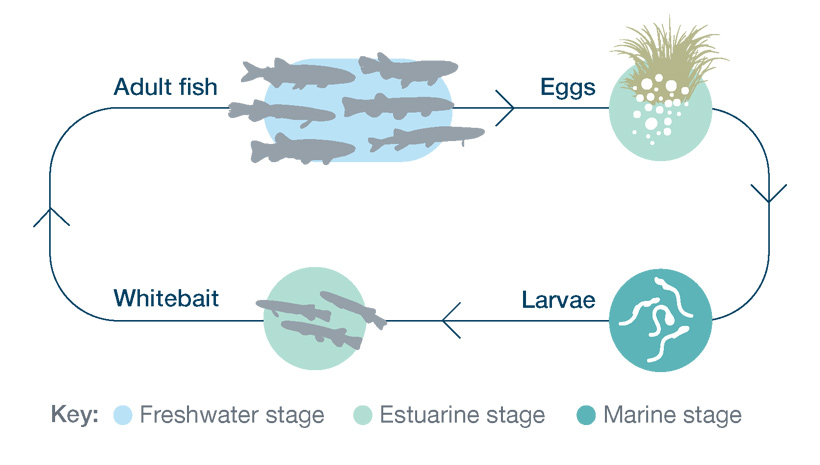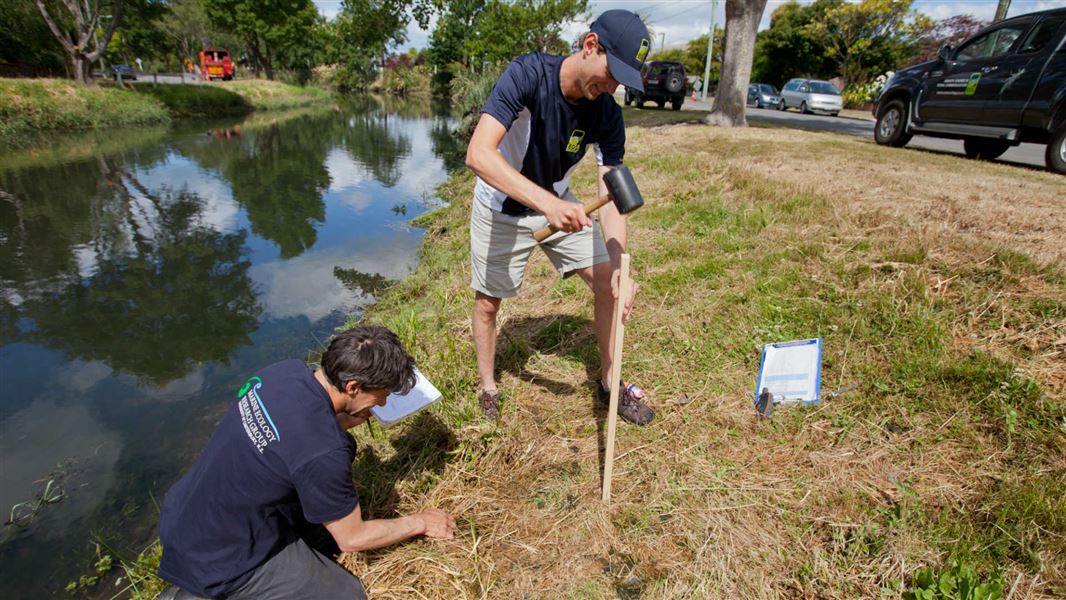About whitebait
The fish caught as whitebait are:
Inanga are the most common fish in whitebait catches, making up about 85% of the total number. Kōaro and banded kōkopu make up a larger proportion (5-10% each) than the remaining species (less than 1%). This mix of species can vary around the country and at different times during the whitebait fishing season. Sometimes other species like eels are caught along with the common whitebait species.
Whitebait are migratory galaxiids
Apart from common smelt, the species caught as whitebait are all migratory galaxiids. Migratory galaxiids move between freshwater and the sea during their lives, and whitebait are juvenile fish returning to freshwater from the sea.
The name galaxiid comes from the patterns on the skin of adult fish that look like a galaxy of stars. Although galaxiids are found in many places in the Southern Hemisphere, banded, giant and shortjaw kōkopu only exist in New Zealand. New Zealand also has many non-migratory galaxiid species that stay in freshwater all their lives.
Our galaxiids are generally nocturnal and very good at hiding. They find shelter and food in lowland streams, rivers and lakes.
Migratory galaxiids all have a similar lifecycle, and spend time in freshwater as well as the ocean:
- adults release eggs and milt (sperm)
- eggs are laid and fertilised in vegetation beside streams and rivers
- eggs hatch and larvae are washed downstream into the ocean
- larvae grow into juvenile fish and migrate upstream in the spring
- juvenile fish grow into adults.
Because migratory galaxiids use many different habitats to complete their lifecycle, all these habitats have to be healthy and accessible for them to thrive.

Inanga lifecycle
Image: DOC
Why numbers of migratory fish are declining
Loss of habitat
Many of the reasons whitebait numbers are declining relate to threats and changes in their habitat.
Adult whitebait need clean, healthy waterways to live in and breed, but in the last 100 years we have lost large areas of adult and spawning habitat due to:
- the draining of wetlands and removal of vegetation beside streams. Whitebait use these areas for shade and protection.
- barriers to fish passage. Barriers in waterways, like dams and overhanging culverts stop migrating whitebait from reaching upstream habitat.
- excess sediment. Too much sediment blocks the spaces between stones on the stream bed, reducing the habitat for invertebrates, such as crayfish/kōura, which adult fish feed on.
- pollution from land. Pollution reduces the water quality in streams and rivers for all aquatic life.
- introduced and invasive plants and weeds that clog up the places where whitebait live.
Eggs eaten by rats and mice
Migratory galaxiids lay their eggs beside streams and rivers. Depending on the fish species, the eggs are tucked into grasses or placed high on stream banks to develop into larvae. During this time they are vulnerable to being eaten by rats and mice.
Trout, salmon and whitebait fishing
Introduced sports fish like trout and pest fish like gambusia compete for habitat and prey on whitebait.
Whitebait fishing is another pressure on whitebait populations.
What you can do to help
There are many ways to can help increase whitebait populations:
When whitebaiting
- Follow the whitebait fishing regulations.
- Keep your whitebait catch small, take only what you need for a feed.
When not whitebaiting
- Fence off waterways to keep farm animals out.
- Replant streams on your property with natives. Keep streams free from pest plants and fish.
- Keep streams free from pest plants and fish.
- Ensure culverts, weirs, dams, and floodgates on your land are fish-friendly.
- Get involved in a local community project to fence and plant local streams.
- Learn more about whitebait and where they live through Whitebait Connection.
- Join Whitebait Watch and help keep track of where whitebait hang out.
-
Learn from Mountains to the Sea Conservation Trust videos how to identify then restore spawning areas.
Keep invasive species out of our waterways
Introduced invasive freshwater pests like didymo and lindavia (microscopic algae) and gold clam (shellfish) threaten the health of our waterways.
To help stop them spreading, always check that your footwear (including waders), vehicles and fishing equipment are clean and dry before going into or moving between, waterways. You could also choose to use your gear on only one river.
Use the 'Check, Clean, Dry' method to reduce the chances of spreading freshwater pests.
